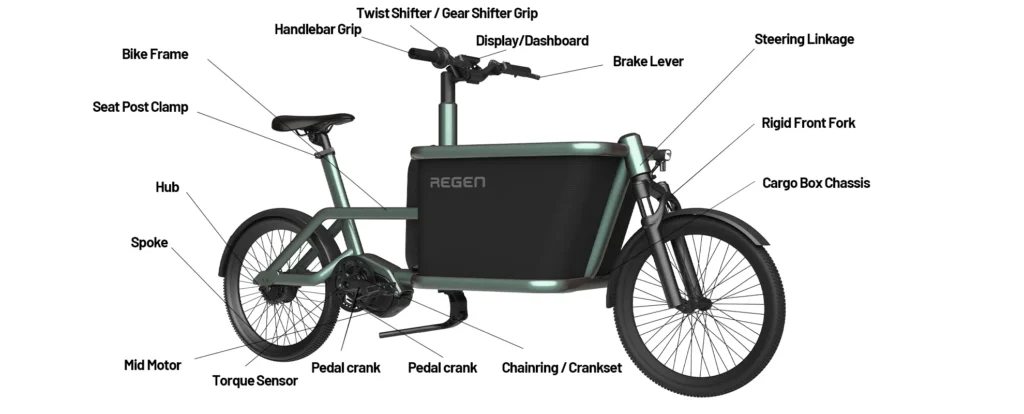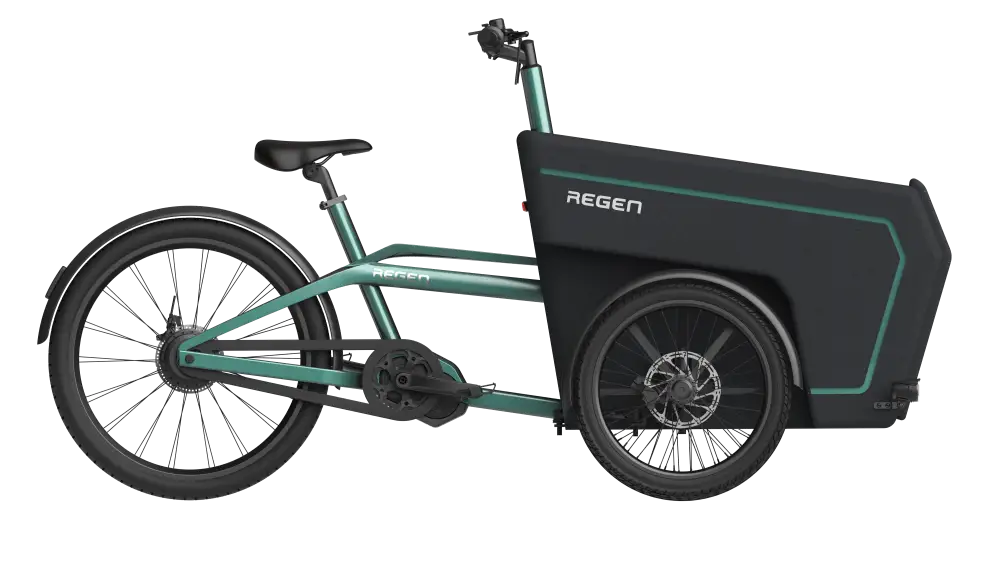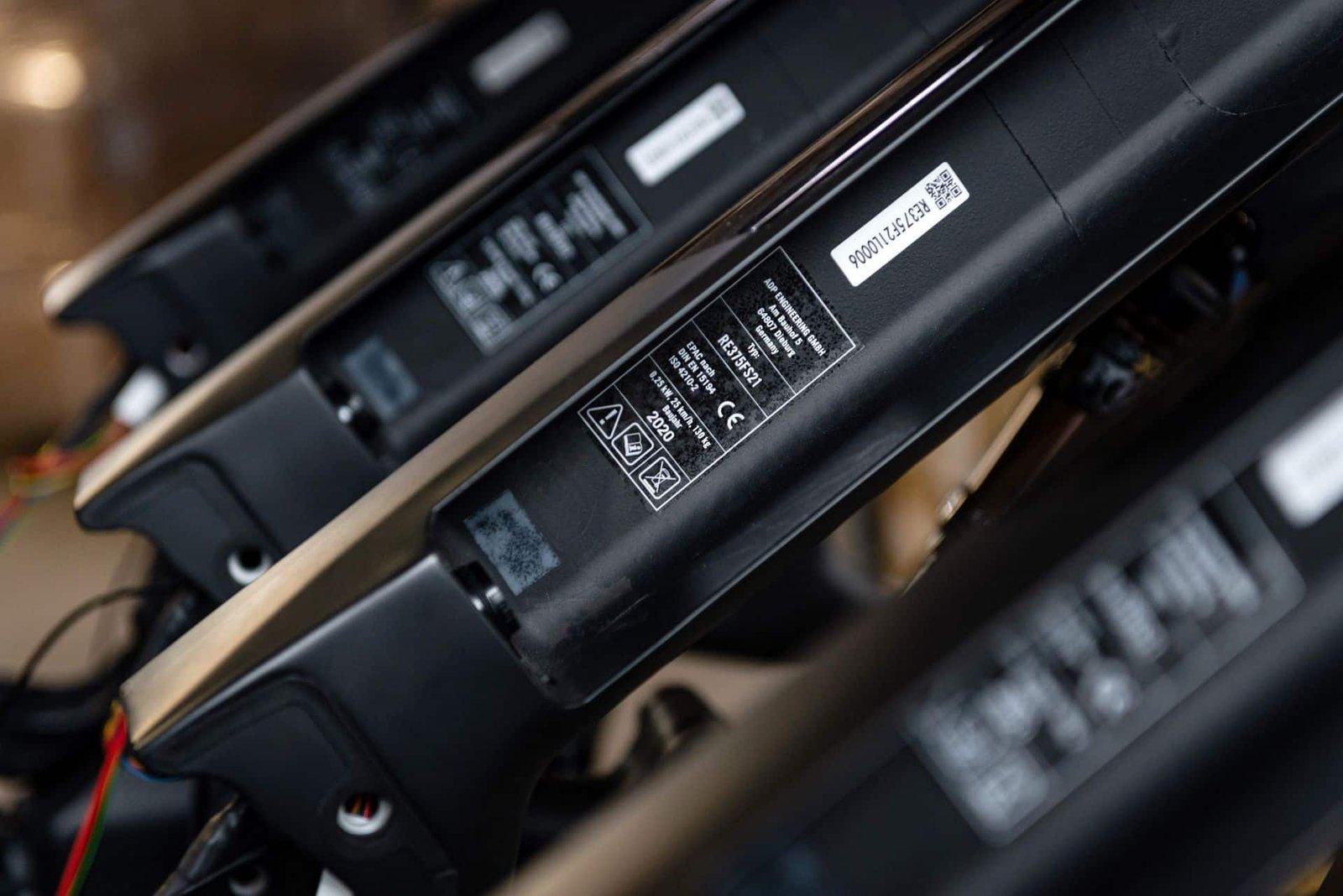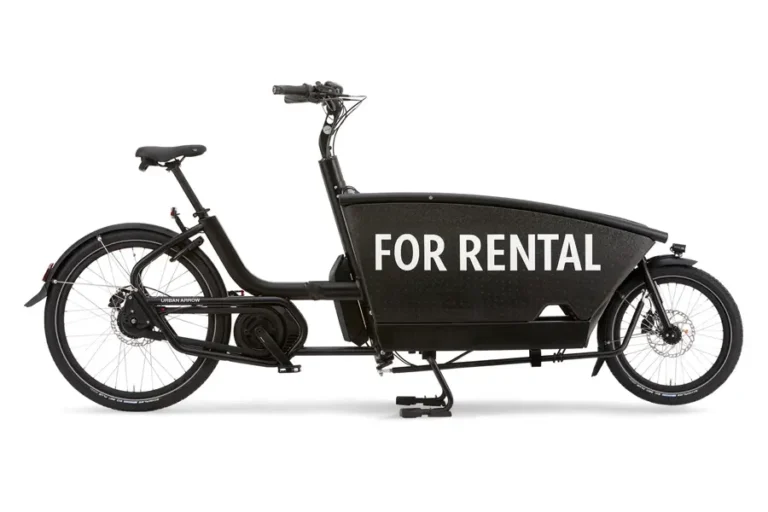Lastcykler forandrer den måde, vi transporterer varer og mennesker på i bymiljøer. Men i modsætning til en almindelig cykel, ladcykler- især elektriske - består af dusinvis af specialbyggede komponenter, som hver især spiller en afgørende rolle for funktionalitet, sikkerhed og brugervenlighed.
Uanset om du er førstegangskøber, planlægger af bylogistik eller virksomhedsejer, der ønsker at købe en flåde, giver denne guide en komplet gennemgang af de vigtigste komponenter i en ladcykel. Vi forklarer, hvad hver del gør, hvordan den passer ind i det store billede, og hvad man skal overveje, når man vælger eller vedligeholder en.
💡 Vil du reducere vedligeholdelsesomkostningerne gennem smartere komponentvalg? Se vores guide til valg af modulære dele.

1. Strukturelle komponenter (designet internt)
Disse komponenter udgør ladcyklens fysiske struktur og er ofte specialudviklet af producenter som Regen for at sikre styrke, sikkerhed og kompatibilitet med forskellige brugssituationer.
Ramme
Grundlaget for enhver ladcykel. Vores rammer er typisk lavet af 6061-T6-aluminium i luft- og rumfartskvalitet eller forstærket stål, hvilket giver et højt styrke/vægt-forhold.
- Lange John: Bagageboks foran mellem styr og forhjul
- Langhale: Forlænget bagagebærer
- Trehjulet cykel: To forhjul eller to baghjul til balance
📚 Få mere at vide:
Hvorfor er 6061-T6 aluminium det bedste materiale til stel til ladcykler?
1.2 Stiv forgaffel
Gaflen forbinder forhjulet med stellet. Stive gafler er stærke, lette og kræver ingen vedligeholdelse - ideelt til lastbærende cykler. Nogle ladcykler bruger affjedrede forgafler for at forbedre kørekomforten.
1.3 Bagagebærer
Bagagebæreren er monteret over baghjulet eller i den forreste sektion og kan bære tasker, transportkasser eller sæder.
1.4 Kurv
Kurve er lettere og mindre end lastkasser og er perfekte til personlige ting. Normalt monteret foran.
1.5 Cargo Box Chassis
Denne underramme forstærker kassen og forbinder den med hovedrammen. Den skal være robust for at absorbere vibrationer fra vejen.
1.6 Lastkasse
Dit vigtigste lastrum. Materialerne spænder fra krydsfiner i marinekvalitet til sprøjtestøbt plast.
- Familiebrug: Omfatter ofte sæder og sikkerhedsseler
- Erhvervsmæssig brug: Kan mærkes, isoleres eller nedkøles
📦 Læs: Hvordan brugerdefinerede fragtkasser øger brandgenkendelsen
1.7 Lastsæde
Valgfri siddeplads i bagagerummet, især til børn. Bør omfatte selepunkter og vejrbestandige materialer.
1.8 Styretøjets kobling
Et vigtigt system i Long John-ladcykler. Koblingen forbinder styret med forhjulet via stænger eller kabler.
Er du ikke sikker på, hvordan det fungerer? Vores forklaring på styringsmekanismer forklarer det.
1.9 Ramme til baldakin
Dette understøtter vejrbestandige dæksler til bagagerummet - afgørende for komforten i regnfulde klimaer.
1.10 Rør til styr
Forbinder styret med forgaflen eller styretøjet. Justerbart design understøtter ergonomisk kørsel.
1.11 Regndæksel
Klar, fleksibel baldakin af PVC eller stof, der holder passagerer og varer tørre. Modulære muligheder forbedrer fleksibiliteten og reducerer udskiftningsomkostningerne.


Kun 20 MOQ-cykler for at komme i gang
Tilpasset el-ladcykel - RS01
Uanset om du er et voksende brand eller en lokal butik, er vores kraftige ladcykler din billet til den blomstrende verden af miljøvenlig levering. Lad os køre!
2. Elektriske komponenter (strøm og styring)
Elektriske ladcykler er afhængige af et velkoordineret elektronisk system, der hjælper med at flytte tung last med lethed og effektivitet. Nedenfor er en oversigt over de vigtigste elektriske dele, deres funktion, og hvordan de understøtter cyklens samlede ydeevne:
| En del | Navn | Definition og rolle i ladcykel |
|---|---|---|
| 2.1 | Motor | Omdanner elektrisk energi til mekanisk kraft for at hjælpe med at træde i pedalerne. Giver det nødvendige drejningsmoment til at flytte tunge byrder. |
| 2.2 | Controller | Den centrale behandlingsenhed i motorsystemet. Regulerer strømmen baseret på input fra sensorer og brugerindstillinger. |
| 2.3 | Display / instrumentbræt | Monteret på styret viser den kørselsdata i realtid, f.eks. hastighed, strømtilstand, batteristatus og fejlalarmer. |
| 2.4 | Batteri | Lagrer energi til motoren og tilbehøret. Bestemmer rækkevidden og kraftreserven for ladcyklen. |
| 2.5 | Sensorer | Registrerer input fra pedalerne for at regulere motorassistancen. Momentsensorer måler pedalkraften; kadencesensorer registrerer pedalrotationen. |
| 2.6 | Forreste lys | Oplyser vejen forude for synlighed og sikkerhed under natkørsel. |
| 2.7 | Baglygte | Øger synligheden bagfra. Ofte integreret med bremse- eller blinklys. |
| 2.8 | Blinklys | Valgfri sikkerhedsfunktion til at angive retningsskift. Nyttig i tæt trafik. |
| 2.9 | Ledningsnet | Elektrisk kabelnetværk, der forbinder alle komponenter. Det skal være vandtæt og godt ført. |
| 2.10 | Integreret afbryder | Knap eller panel, der bruges til at tænde/slukke cyklen og styre lys, strømtilstand eller boost. |
| 2.11 | DC-konverter | Konverterer højspændingsbatteriudgang til 5V/12V til USB-porte, telefonopladning eller IoT-systemer. |
2.1 Motor
Motoren er motoren i en elektrisk ladcykel. Den øger rytterens pedalkraft og er afgørende for at kunne transportere tung last eller bestige bakker. To typer er almindelige:
- Midterdrevsmotor: Placeret nær kranken og overfører kraften direkte til drivlinjen. Giver bedre bjergbestigning og belastningsfordeling.
- Navmotor: Indbygget i for- eller baghjulet. Mere støjsvag og enklere, men mindre effektiv under høj belastning.
2.2 Controller
Denne komponent fungerer som en hjerne, der modtager signaler fra pedaler, gashåndtag og sensorer for at styre, hvor meget kraft motoren leverer. Det sikrer jævn acceleration og effektiv energiudnyttelse.
2.3 Skærm / instrumentbræt
Din grænseflade i cockpittet. Det giver data i realtid om hastighed, batteriniveau, distance, assistancetilstand og diagnostik. Avancerede displays kan omfatte GPS eller Bluetooth.
2.4 Batteri
Batterierne, som typisk er lithium-ion, er monteret i stellet eller på bagagebæreren. Et batteri med høj kapacitet (f.eks. 720Wh) kan understøtte over 60 km assisteret kørsel. Regen bruger batterier, der er certificeret i henhold til EU/CE-standarder fra mærker som LG og Panasonic.
2.5 Sensor
To hovedtyper:
- Moment-sensor: Måler den kraft, der anvendes på pedalerne. Giver en naturlig, responsiv fornemmelse.
- Kadencesensor: Måler, om og hvor hurtigt du træder i pedalerne. Enklere, men mindre intuitiv.
2,6-2,8 lys
For- og baglygter er påkrævet i de fleste regioner. Avancerede modeller har automatiske forlygter, bremselys og blinklys monteret på styret. Det forbedrer sikkerheden i stærkt trafikerede områder.
2.9 Ledningsnet
Dette er nervesystemet i det elektriske setup. Et veldesignet ledningsnet sikrer stabile forbindelser, undgår kortslutninger og er modstandsdygtigt over for vand og korrosion.
2.10 Integreret kontakt
Mange Regen-ladcykler har tommelfingerkontakter integreret i håndtaget på styret, så man hurtigt kan skifte mellem strømniveauer, lys eller horn.
2.11 DC-omformer
Nyttigt for leveringsflåder eller bycyklister, der er afhængige af smartphones eller IoT-enheder. Konverterer batteristrøm til brugbare spændinger til opladning af tilbehør eller strøm til hjælpeenheder.
3. Standard cykelkomponenter (udskiftelige)
Disse dele bruges ofte i almindelige cykler, men forstærkes eller tilpasses ofte i ladcykler for at imødekomme ekstra vægt, belastning og funktionalitet.
| En del | Navn | Definition og rolle i ladcykel |
| 3.1 | Gaffel | Holder forhjulet og forbinder det med stellet. Affjedrede gafler øger komforten; stive gafler er stærkere til tung last. |
| 3.2 | Stilk | Forbinder styret med gaflen og bestemmer rytterens kropsholdning. |
| 3.3 | Styr | Gør det muligt at styre og indeholder ofte kontrolsystemer og greb. |
| 3.4 | Greb | Gummi- eller skumhåndtag for komfort og skridsikker kontrol. |
| 3.5 | Headset | Lejesystem, der muliggør jævn rotation af styret. |
| 3.6 | Håndsving | Armen, der forbinder pedalen med krankboksen. Overfører kraft. |
| 3.7 | Krankboks | Indeholder aksel og lejer. Skal forstærkes til lastanvendelse. |
| 3.8 | Pedal | Hvor rytteren anvender kraft. Større pedaler giver bedre stabilitet. |
| 3.9 | Sadel | Sædet. Brede, polstrede sadler er ideelle til længere ture. |
| 3.10 | Sadelpind | Forbinder sadlen med stellet. Kan justeres i højden. |
| 3.11 | Sædeklemme | Holder sadelpinden på plads. Quick-release klemmer hjælper delte ryttere. |
| 3.12 | Kædehjul / kranksæt | Det vigtigste forreste gear. Påvirker pedalmoment og hastighed. |
| 3.13 | Frihjul / Kassette | Bageste geargruppe. Definerer gearområde. |
| 3.14 | Indvendigt gearnav | Lukket gearsystem bagpå. Lav vedligeholdelse og vejrbestandig. |
| 3.15 | Navet | Hjulcenter, der kan indeholde gear, motor- eller bremsedele. |
| 3.16 | Bremsegreb | Håndtag på styret til at aktivere bremserne. |
| 3.17 | Bremsekaliper | Påfører tryk på bremseskiven for at opnå bremsekraft. |
| 3.18 | Bremseskive | Roterende skive, som kaliberen klemmer på. Findes i skivebremsesystemer. |
| 3.19 | Hastighedssensor | Måler hjulets hastighed for at hjælpe med at regulere pedalassistancen. |
| 3.20 | Hjul | Det roterende element. Lastcykler bruger stærkere fælge og dæk med højere belastning. |
| 3.21 | Inderrør | Oppustelig slange inde i dækket. |
| 3.22 | Dæk | Udvendig gummibelægning. Skal kunne bære tunge belastninger og modstå punkteringer. |
| 3.23 | Støddæmper | Reducerer vibrationer og forbedrer komforten. Findes i high-end modeller. |
| 3.24 | Luftfjeder | Affjedringselement, der bruger trykluft. Lettere end spiralfjedre. |
| 3.25 | Reflektor | Forbedrer synligheden. Påkrævet i mange regioner. |
| 3.26 | Stænkskærm | Blokerer stænk fra vand og mudder. Holder rytteren og lasten ren. |
| 3.27 | Lås | Forhindrer tyveri. Rammelåse er almindelige på europæiske ladcykler. |
| 3.28 | Tal | Forbinder nav med fælg. Skal forstærkes i lasthjul. |
| 3.29 | Kæde | Overfører kraft fra krumtap til baghjul. Skal kunne modstå spænding og belastning. |
| 3.30 | Fastgørelseselementer og hardware | Indeholder møtrikker, bolte, klemmer og hængsler, der er vigtige for den strukturelle integritet. |
Anbefales: Hydrauliske vs. mekaniske bremser - hvad er det rigtige til ladcykler?
Se også her: Hvordan dæk til ladcykler adskiller sig fra standard eBikes
Hvordan disse dele arbejder sammen
Når disse komponenter er velintegrerede, skaber de et sikkert, komfortabelt og effektivt lastkøretøj. Et ubalanceret system (f.eks. svage bremser eller underdrevne motorer) går ud over ydeevnen.
Afsluttende tanker
Lastcykler er ikke bare overdimensionerede cykler - de er mobile systemer, der er designet til nytte, effektivitet og sikkerhed. Uanset om du skræddersyr din første familiecykel eller administrerer en logistikflåde, giver forståelse af komponenterne mulighed for at træffe bedre beslutninger.
👨🔧 Vil du tale med vores ingeniører om dit byggeri? Book en gratis konsultation







